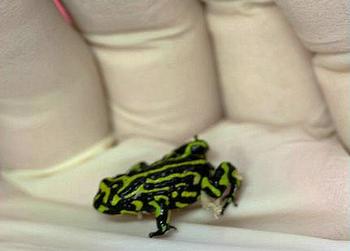Frog Survivors Emerge From Battle With Killer Fungus
CANBERRA, Australia, June 15, 2015 (ENS) – Against all odds, some Australian native frog species are surviving the lethal chytrid fungus, while others are losing their lives to it, new research shows.
The whistling tree frog is beating the deadly fungus, and so is the alpine tree frog. But the critically endangered yellow-and-black striped corroboree frog is disappearing, according to studies by the ARC Centre of Excellence for Environmental Decisions, CEED, an Australian Research Council partnership among universities and research institutions.
The research is revealing what causes frogs to live or die – providing scientists crucial clues in the fight to save Australia’s remaining frogs, says Ben Scheele, who just completed his PhD with CEED at the Australian National University.
“Frogs catch the fungal infection through contact with infected water or direct contact with other infected frogs,” says Scheele. “It attacks the skin, making it difficult for the frogs to breathe, and this stops their hearts.”
The chytrid fungus has been spread by the African clawed frog, which carries it but is immune. For decades these African frogs were exported worldwide after a 1934 discovery that they could be used for pregnancy tests in humans.
“Chytrid has since been found in over 500 amphibian species, and is now on all continents except Antarctica,” Scheele says. It has driven the decline of over 200 species, of which 113 are thought to be extinct. As Australian frogs face the same fate, we decided to investigate this killer, focusing on its long term effects.”
Good news is that the whistling tree frog is recovering, since its population crashed in the 1980s, Scheele says. Surveys show that year by year, the species is returning to habitats it used to occupy decades ago, and has even been found at 39 new sites.
“High quality habitat plays an important role. Many of the sites we looked at contained coarse woody debris which provided refuge for new colonizers. These ponds also had more plants and stable water levels which are needed to protect developing frog eggs and provide habitat for tadpoles,” he explains.
Monitoring by the New South Wales Office of Environment and Heritage shows that numbers of endangered alpine tree frogs, which declined in recent decades, now appear stable.
“Our studies reveal this is because chytrid is rare in their tadpoles and juvenile frogs, which enables the next generation to spread out in its woodland habitat free of the disease,” says Scheele.
“Although adult frogs later return to the wetlands to mate and contract the fungus, they are usually able to breed before they die,” he said.

Researcher holds a northern corroboree frog. The species is dying out due to the chytrid fungus. (Photo by jennofarc)
But the northern corroboree frog, once abundant in Kosciuszko and Namadgi National Parks, is being pushed closer to extinction every day.
While some frogs survived the fungus in the 1980s, they are still infected through common eastern froglets that carry chytrid and share the corroboree frog’s habitats.
“For frogs that are losing the battle, we’ll have to breed them in captivity or transfer them to environments that can help get rid of the fungus,” says Scheele. “These include ponds with shallow edge areas that heat up rapidly, as chytrid dies in warm temperatures. We can also deepen ponds and fill them with water, preventing them from drying during droughts and killing tadpoles.”
Scheele says Australians can help by monitoring their local frogs, through programs such as FrogWatch. They can help raise public awareness of how to protect our amphibians.
“Our results show that given enough time, some amphibian species can recover from diseases, provided that high quality habitat is protected,” said Scheele. “So the simplest thing we can do for these species is to prevent further habitat loss.”
The study “Low impact of chytridiomycosis on frog recruitment enables persistence in refuges despite high adult mortality” by Scheele, BC, DA Hunter, LF Skerratt, LA Brannelly and DA Driscoll was published in the journal “Biological Conservation.” See: http://bit.ly/1FmJAHt
The study “Decline and re-expansion of an amphibian with high prevalence of chytrid fungus” by Scheele, BC, F Guarino, W Osborne, DA Hunter, LF Skerratt and DA Driscoll was published in Biological Conservation. See: http://bit.ly/1Hmiks5
Copyright Environment News Service (ENS) 2015. All rights reserved.
http://ens-newswire.com/2015/06/15/frog-survivors-emerge-from-battle-with-killer-fungus/
